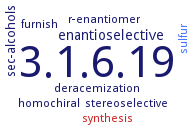3.1.6.19: (R)-specific secondary-alkylsulfatase (type III)
This is an abbreviated version!
For detailed information about (R)-specific secondary-alkylsulfatase (type III), go to the full flat file.

Reaction
Synonyms
(R)-specific sec-alkylsulfatase, Pisa1, S3 secondary alkylsulphohydrolase, sec-alkylsulfatase, sulfatase RS2
ECTree
Advanced search results
Systematic Name
Systematic Name on EC 3.1.6.19 - (R)-specific secondary-alkylsulfatase (type III)
Please wait a moment until all data is loaded. This message will disappear when all data is loaded.
(R)-secondary-alkyl sulfate sulfohydrolase [(S)-secondary-alcohol-forming]
Sulfatase enzymes are classified as type I, in which the key catalytic residue is 3-oxo-L-alanine, type II, which are non-heme iron-dependent dioxygenases, or type III, whose catalytic domain adopts a metallo-beta-lactamase fold and binds two zinc ions as cofactors. This enzyme belongs to the type III sulfatase family. The enzyme from the bacterium Rhodococcus ruber prefers linear secondary-alkyl sulfate esters, particularly octan-2-yl, octan-3-yl, and octan-4-yl sulfates [1]. The enzyme from the bacterium Pseudomonas sp. DSM6611 utilizes a range of secondary-alkyl sulfate esters bearing aromatic, olefinic and acetylenic moieties. Hydrolysis proceeds through inversion of the configuration at the stereogenic carbon atom, resulting in perfect enantioselectivity. cf. EC 3.1.6.1, arylsulfatase (type I), and EC 1.14.11.77, alkyl sulfatase (type II).


 results (
results ( results (
results ( top
top





